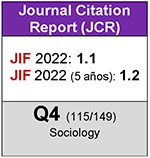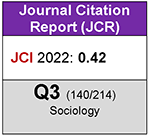eISSN: 1988-5903
ISSN: 0210-5233
DOI: 10.5477/cis/reis
Submissions
Submission Preparation Checklist
As part of the submission process, authors are required to check off their submission's compliance with all of the following items, and submissions may be returned to authors that do not adhere to these guidelines.- Work has not been published or has not been subject to consideration by any other journal (or an explanation regarding the editor's comments has been provided).
- Work has been presented in a communication or congress. If so, work must have been substantially amended in order to be published in journal, and this situation must be explained by the author.
- All authors who have participated in the preparation of the manuscript must give their consent to submit it for evaluation, specifying the criteria chosen to decide the order of signature and adding the specific contribution made by each one.
- Those individuals who even though they didn’t work but contributed to the project development and are authorized to be in this project, must be included under acknowledgements.
- Follow journal guidelines in regard with bibliographical references and cites. Each author shall be responsible for the citations appearing in text. See examples in previous issues.
- File will be submitted in OpenOffice format, Microsoft Word, RTF or WordPerfect, and will follow the journal rules.
- Text is reached to the maximum number of words established (including title, abstracts, keywords, tables, bibliography, footnotes and annexes): 9,000 words for articles, 5,000 for research notes and notes on the data bank from the CIS, 3,500 for bibliographic essays and 2,500 for book reviews.
- The text is single spaced; 12 point font size; italics are used instead of underlining (except in URLs); and all illustrations, figures, and tables are placed at the end of the text.
- Whenever possible, URL addresses are provided for references.
- Text must follow the stylistic and bibliographic requirements summarized in the author’s guidelines under the About the Journal section.
- An anonymous version of the text is attached without acknowledgments and authors to facilitate their anonymous evaluation.
- Research complies with the ethical indications of the REIS, as well as the legal requirements of the country where it was carried out.
- It is recommended that the authors of published papers with research data including the sex variable, report in the conclusions possible differences between sexes.
- Add a source of funding for the research that has resulted in the published work. The funding agency(ies) and the code(s) of the project(s) must be indicated within the framework of which the research that has given rise to the research has been carried out. to the post. This data must be referenced in the article by the authors and be collected by the journal in the metadata it stores.
Articles
Deberán ser trabajos de investigación originales, de carácter teórico o empírico, con un adecuado desarrollo teórico o analítico y tener el formato habitual de las revistas científicas especializadas.
Notas de Investigación
Deberán informar brevemente de hallazgos singulares, nuevas aportaciones, replicación de hallazgos o añadidos a la literatura científica que justifiquen su publicación sin la extensión y desarrollo teóricos o el detalle analítico requerido a los artículos.
Ensayos bibliográficos
Analizarán dos o más publicaciones recientes sobre el mismo tema; podrán tener notas a pie de página y referencias bibliográficas al final.
Crítica de libros
Serán trabajos ensayísticos que analicen novedades editoriales de interés académico y científico.
Notas sobre el banco de datos del CIS
Deberán presentar trabajos en los que se realice una explotación y análisis de tendencias de evolución sobre temas de actualidad e interés sociológico o politológicos, empleando el Banco de Datos del CIS.
Copyright Notice
The contents of the REIS journal are subject to the Creative Commons Attribution-ShareAlike 4.0 International License (CC BY-SA 4.0). Allow Share — copy and redistribute the material in any medium or format, Adapt — remix, transform, and build upon the material for any purpose, including commercially.
![]()
According to guidelines of the Intellectual Property Law (Spain), authors will freely assign, on a non-exclusive basis and without a time limit, the rights to disseminate, reproduce, communicate and distribute, in any current or future format (print or electronic), to the Spanish Journal of Sociological Research.
By submitting the work, the author declares that his work has not been previously published or sent to another journal for consideration.
Once the work is published in the journal, the author maintains the right to publish his work in open access institutional repositories or other platforms, always providing the reference source, in this case Reis Journal and editor Centro de Investigaciones Sociologicas (CIS).
Privacy Statement
Names and e-mails included in this journal will be exclusively used for the purposes stated therein and shall not be provided to third parties or for any other purpose.
More information can fe found on the CIS website, in the citizen services and data protection section. In the following link you can find detailed information on access to the regulations and the different forms https://www.cis.es/servicios-ciudadano/proteccion-de-datos-caracter-personal.







